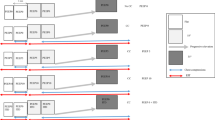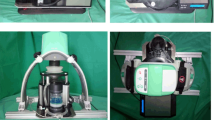Abstract
When the ribcage and abdomen are compressed during cardiopulmonary resuscitation (CPR), the effect on intrathoracic pressure, and therefore on haemodynamics, cannot be quantitatively predicted without a physiologically based mathematical model of chest wall dynamics. Using such a model, we compared model simulations of pleural Ppl and abdominal Pab pressures with those from dog experiments in which the compression of the ribcage was delayed from 0 to 500 ms after compression of the abdomen. Integrals of Ppl and transdiaphragmatic pressure, Pdi=Pab−Ppl, over their positive and negative values during a cycle were chosen as indices of driving pressures for cardiac output. Both from the model output and experimental data, we found that the positive ppl integral PPI tends to increase with a longer delay between ribcage and abdominal compressions. The negative Ppl integral NPI, however, tends to decrease according to the model predictions and data. Furthermore, the positive and negative integrals of Pdl also tend to change with delay time in the opposite way, as shown by both the model simulations and the experiments. Our results show that chest wall tissues modify the externally applied pressures, thereby not allowing us to use the externally applied pressure sources directly as the driving pressure of the cardiovascular system under study. The optimal conditions for haemodynamics during CPR require a compromise between the positive and negative integral indices. Prediction of the optimal haemodynamics from externally applied pressures requires the coupling of appropriate physiological models of chest wall dynamics and haemodynamics.
Similar content being viewed by others
Abbreviations
- P :
-
pressure (force/area)
- V :
-
volume
- Z :
-
impedance function
- σ:
-
stress (force/area)
- \(\hat \sigma \) :
-
active stress (force/area)
- ϕ:
-
diaphragm position ratio,A rt /A rc
- Φ:
-
area ratio,A rd /(A rb +A rd )
- X i :
-
distance of structurei
- δX i :
-
displacement from operating point of structurei
- K 1i ,K 2i ,K 3i ,K 4i :
-
empirical constants of pressure/displacement relationship of structure
- alv :
-
alveolar
- ab :
-
abdomen
- ao :
-
airway opening
- aw :
-
airway
- di :
-
diaphragm
- l :
-
lung
- pl :
-
pleural
- rc :
-
rib cage
- rd :
-
diaphragm apposed ribcage
- rl :
-
moving lung apposed ribcage
- vr :
-
ribcage vest
- va :
-
abdominal vest
References
Babbs, C. F., Ralston, S. H. andGeddes, L. S. (1984a) Theoretical advantages of abdominal counterpulsation in CPR as demonstrated in a simple electrical model of the circulation.Ann. Emerg. Med.,13, 660–671.
Babbs, C. F., Weaver, J. C., Ralston, S. H. andGeddes, L. A. (1984b) cardiac, thoracic, and abdominal pump mechanisms in CPR: studies in an electrical model of the circulation.Am. J. Emerg. Med.,2, 299–308.
Ben-Haim, S. M., Anutchnik, C. andDinnar, U. (1988) A computer controller for vest cardiopulmonary resuscitation (CPR).IEEE Trans.,BME-35, 413–416.
Ben-Haim, S. A. andSaidel, G. M. (1989) A mathematical analysis of chest wall static and quasi static mechanics.Ann. Biomed. Eng., (in press).
Ben-Haim, S. A., Shofti, R., Ostrow, B. andDinnar, U. (1990). The effect of vest cardiopulmonary resuscitation (CPR) rate on cardiac output and coronary blood flow.Crit Care Med., (in press).
Beyar, R., Kishon, Y. andDinnar, U. (1983) Cardiopulmonary resuscitation mechanisms: a computer model. Biomed. Eng. Trans: Proc. of the 5th Ann. Conf. Front. of Eng. & Comput. in Health Care, Columbus, Ohio, USA.
Beyar, R., Kimmel, E., Sideman, S., Dinnar, Y. andKishon, Y. (1984) Effect of thoracic and abdominal pressure waves on blood flow in cardiopulmonary resuscitation.Int. J. Heat Mass Transfer,27, 1473–1483.
Chandra, N., Cohen, J. M. andTsilik, J. (1979) Negative air way pressure between compressions augments carotid flow during CPR.Circ.,50, 46–50.
Chandra, N., Rudikoff, M. andWeisfeldt, M. L. (1980) Simultaneous chest compression and ventilation at high airway pressure during cardiopulmonary resuscitation.Lancet,1, 175–178.
Chandra, N., Weisfeldt, M. L., Tsitlik, J., Vaghaiwalla, F., Snyder, L. D., Hoffecker, M. andRudikoff, M. (1981) Augmentation of carotid flow during CPR by ventilation at high airway pressure simultaneous with chest compression.Am. J. Cardiol.,48, 1053–1063.
Criley, J. M., Blaufuss, A. H. andKissel, G. L. (1976) Cough induced cardiac compression.JAMA,236, 1246–1250.
Hubay, C. A., Waltz, R. C., Breecher, G. A., Praglin, J. andHingson, A. (1954) Circulatory dynamics of venous return during positive-negative pressure respiration.Anesthesiol.,15, 445–461.
Koehler, R. C., Chandra, N., Guerci, A. D., Tsitlik, J., Traystman, R. J., Rogers, M. C. andWiesfeldt, M. L. (1983) augmentation of cerebral perfusion by simultaneous chest compression and lung inflation with abdominal binding after cardiac arrest in dogs.Circ.67, 266–275.
Kouwenhoven, W. B., Jude, J. R. andKnickerbocker, G. G. (1960) Closed chest cardiac massage.JAMA,173, 1064–1067.
Lin, C. K., Levenson, H. andYamashiro, S. M. (1987) Optimization of coronary blood flow during cardiopulmonary resuscitation (CPR).IEEE Trans.,BME-34, 473–481.
Luce, J. M., Ross, B. K., O'Quin, R. J., Culver, B. H., Sivarajan, M., Amory, D. W., Niskanen, R. A., Alferness, C. A., Kirk, W. L., Pierson, L. B. andButler, J. (1983) Regional blood flow during cardiopulmonary resuscitation in dogs using simultaneous and nonsimultaneous compression and ventilation.Circ.,67, 258–265.
Mashiro, I., Cohn, J. N., Heckel, R., Nelson, R. R. andFranciosa, J. A. (1978) Left and right ventricular dimensions during ventricular fibrillation in the dog.Am. J. Physiol.,235, H231-H236.
Milic-Emili, J., Mead, J. M., Turner, J. andGlauser, E. M. (1964) Improved technique for estimating pleural pressure from esophageal balloons.J. Appl. Physiol.,19, 207–211.
Niemann, J. T., Rosborough, J., Hansknecht, M., Garner, D. andCriley, J. M. (1981) Pressure-synchronized cineangiography during experimental cardiopulmonary resuscitation.Circ.,64, 985–1002.
Redding, J. S. (1971) Abdominal compression in cardiopulmonary resuscitation.Anesth Analg.,50, 668–675.
Rudikoff, M. T., Maughan, W. L., Efforn, M., Freund, P. andWeisfeldt, M. L. (1980) Mechanisms of blood flow during cardiopulmonary resuscitation.Circ.,61, 345–353.
Taylor, G., Tucker, W. M., Greene, H. L., Rudikoff, M. T. andWeisefeldt, M. L. (1979) Importance of prolonged compression during cardiopulmonary resuscitation in man.N. Engl. J. Med.,296, 1515–1517.
Author information
Authors and Affiliations
Rights and permissions
About this article
Cite this article
Ben-Haim, S.A., Shofti, R., Dinnar, U. et al. Pressures generated by ribcage and abdominal compressions during cardiopulmonary resuscitation. Med. Biol. Eng. Comput. 28, 43–49 (1990). https://doi.org/10.1007/BF02441676
Received:
Accepted:
Issue Date:
DOI: https://doi.org/10.1007/BF02441676




